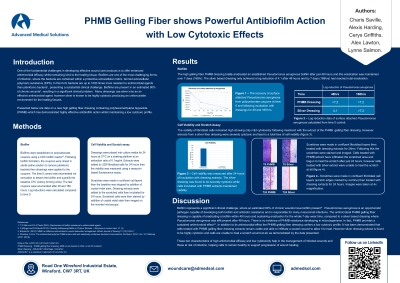Laboratory Research
(LR-047) PHMB High gelling fibre shows powerful antibiofilm action with low cytotoxic effects
Friday, April 28, 2023
7:15 PM - 8:30 PM East Coast USA Time

Cerys Griffiths, BSc – Advanced Medical solutions; Alexis Harding, BSc; Alex Lawton, BSc; Lynne Salmon, BSc
Introduction: A huge challenge in wound care is to develop products that are effective at killing microbial infection, with biofilm representing the most challenging form, yet remain kind to the healing tissues. We have developed a high gelling fibre dressing containing PHMB which demonstrates effective antibiofilm action whilst showing low cytotoxicity to mammalian cells. This combination of action demonstrates an advantage over silver containing products which are known to be highly cytotoxic.
Methods: Antibiofilm – Biofilms were generated using a CDC reactor with clinically relevant organisms. Dressings were then applied to established biofilms for up to seven days to represent the dressing wear time. Following this, the biofilm substrate was enumerated in order to measure the level biofilm remaining.
Cell Viability – Dressings were extracted in cell culture media and then the extracts were added onto fibroblast cells and incubated for 24 hours. Following incubation cell viability was measured using a resazurin based assay to assess cell viability.
Results: The results demonstrate that the dressing is highly effective at reducing biofilm and was able to totally eradicate a pseudomonas biofilm after 48 hours, with the action sustained for the full 7 day test period whilst mammalian cell viability was found to remain high.
Discussion: Biofilms represent a significant clinical challenge, with pseudomonas able to form antibiotic resistant biofilms. Total eradication of a pseudomonas biofilm by the high gelling fibre PHMB dressing represents a promising outcome, this combined with the low cytotoxicity profile should allow wounds to remain free from infection and the cells to remain healthy to support progression of wound healing.
Methods: Antibiofilm – Biofilms were generated using a CDC reactor with clinically relevant organisms. Dressings were then applied to established biofilms for up to seven days to represent the dressing wear time. Following this, the biofilm substrate was enumerated in order to measure the level biofilm remaining.
Cell Viability – Dressings were extracted in cell culture media and then the extracts were added onto fibroblast cells and incubated for 24 hours. Following incubation cell viability was measured using a resazurin based assay to assess cell viability.
Results: The results demonstrate that the dressing is highly effective at reducing biofilm and was able to totally eradicate a pseudomonas biofilm after 48 hours, with the action sustained for the full 7 day test period whilst mammalian cell viability was found to remain high.
Discussion: Biofilms represent a significant clinical challenge, with pseudomonas able to form antibiotic resistant biofilms. Total eradication of a pseudomonas biofilm by the high gelling fibre PHMB dressing represents a promising outcome, this combined with the low cytotoxicity profile should allow wounds to remain free from infection and the cells to remain healthy to support progression of wound healing.

.png)